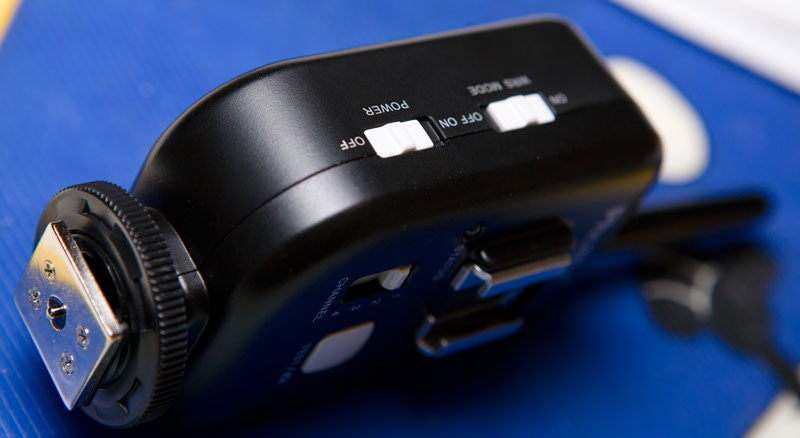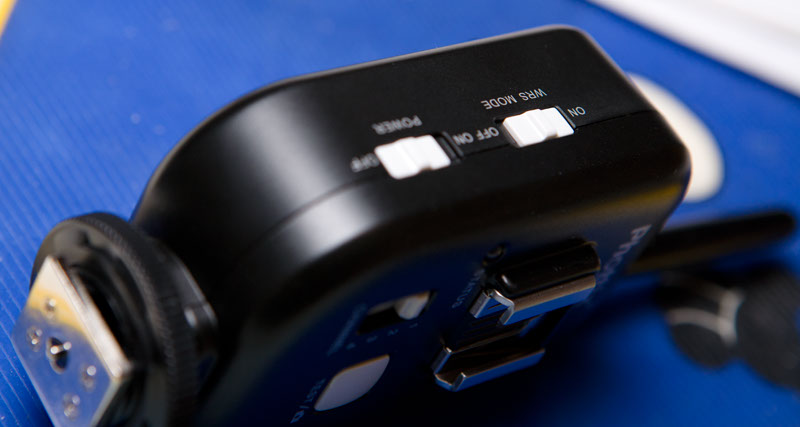Remember: „reviews, tests & hands-ons“.
Just like the Plus II the Atlas are capable of radio triggering most cameras as well. The Phottix itself can be used and operated just like with flash in this mode. All you need is the fitting camera cable. MeinFoto (german retailer) offers them for about 20 Euros each. Again, advantage for the Atlas. Pocket Wizards burn you a much bigger hole into your pockets with about 90 Euros or more (depending on the camera).
I did not test the cables. If you are using the „small Canons“ you can use a simple 2.5mm-cable as well (3.5mm on the other side). I did some quick test with one of these and all worked well.
The Atlas‘ trigger button has two seperate pressure points that can be differentiated easily, so seperate (auto)focussing without wire is perfectly possible.
One Phottix Atlas can even receive and send „at the same time“. Thanks to the „WRS Mode“ one trigger can fire a camera and a flash simultaneously (and synched).
PocketWizard-checklist item 4: triggering cameras (synched as well) – passed!
We checked the interference liabilty (for objects and obstacles in the transmission path) in the same way we did with the FlexTT5 (we compared with another trigger and checked which one worked best through one, then two, then 3 doors and some distance). We compared with only the Hensel StrobeWizard this time (as the results from the Hensel and the Elinchrom Skyport where similar in the last experiment).
We were surprised to find out they acted pretty similar in this regard. Both made it through the wooden door, through the fire prevention door, the steps, the exterior door made out of metal (with wires) and about 3 metres away from that. The Hensel did quit about 1 meter earlier. Taking into account that the receiver for this device is built into the flash and the trigger doesn’t feature an external antenna, that’s quite amazing in compraison to the Atlas. However, the Atlas did also pass this test very well (and, as mentionend, even a hair better).

For testing range we again relied on the same procedure and place as we did in the FlexTT5 test. So we ensured the comparability. Again a Canon 580 EX II was used, slid right into the hot shoe of the Atlas.
As we hoped the Phottix Atlas was able to even exceed the already very good measurements of the FlexTT5 (about 80-85 meters). We got about 120 meters this time. At the edge of this range it occured that for 2 or 3 exposures no flash was triggered, after that it worked flawlessly. One step further away almost no triggering was possible, one step closer every shot flashed. We could not find noticable differences in the way the antenna was hold, neither in the transeiver nor the transmitter.
reliability & conclusion from practical use
I made use of the Atlas for several weeks now and used ‚em on many shootings. Until now they really triggered ANY TIME. There was not a single failure leading to a black frame. That happened seldom but occasionally with my other triggers (Skyport, Strobe Wizard) in the past. Of course this is still much, much better than what I encountered years ago with my cheap „walimex“-triggers which sometimes resulted in more black frames than lighted ones.
I’m still amazed of the robustness of the devices, their reliability and most of all their easy use.
Because of this I use 4 Atlas regulary at shootings now. And I’m thinking of buying some more. Despite having other triggers as well.
The Atlas however allow me to have maximal flexibility AND reliability while remaining very easy to use – features I formost only knew from Gaffa-Tape.
Adding a flashgun to the setup? No problem – it’s integrated into the radio chain in no time without having to struggle with any chords. A quick light measurement? With a sekonic flash meter with integrated radio trigger this is possible without a chord on the meter or fiddeling with a trigger in the hand or on the camera. Mixing different flash brands and even flash types? Easy and quick connect an Atlas to each flash with the included cable (and maybe an adapter) and there you go. And then another light measurement. Or another flashgun. You get it…
price & positioning in the market
The price doesn’t change anything to the very good impression.
Compared to Yongnuo RF-601 they’re quite expensive. Compared to Elinchrom Skyport still a bit. Hensel Strobe Wizards are roughly in the same area.
Pocket Wizard Plus II however, and the Atlas are perfectly comparable, are much more expensive. I would even prefer the Atlas any time, even at the same price. There’s the much better built quality of the shoe, the tightening screw is much bigger (and really easy to use) and the hot shoe on the back is a real addition which makes handling flashguns so much better. I would even prefer the Atlas to the FlexTT5 – given you don’t need the E-TTL- and „Hypersync“-functions. In this case the Phottix are worlds apart in ease of use and appear more robust in some details – the switches convey a better sense of quality as well.

The Phottix Atlas bring in all the pros of the of the PocketWizard Plus II – and some more:
- compatibility with the PW-system, which is already built in flash meters, flahes etc. and can be rented all over the world
- very high reliability
- very easy to use also because of
- the Transceiver-concept
- good built quality
- use of AA batteries/rechargeables for powering (A/C powered use is possible)
- triggering and synchronizing of flashes AND cameras
- easiest integration of flashguns („Speedlights/Speedlites“) into the radio chain

What rating the Phottix Atlas have scored should be obvious by now. They are the first product I tested that score the almost impossible rating of 10 (out of 10) „flashes“. You see, only almost impossible.



